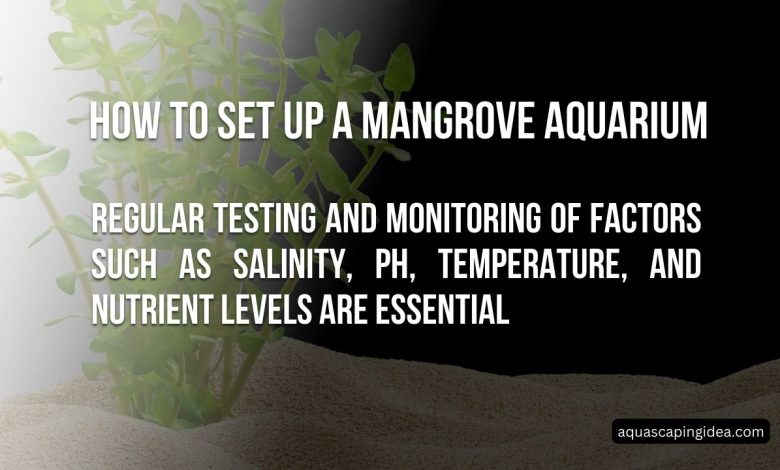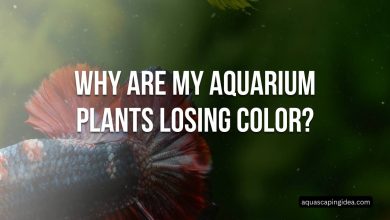How to Set Up a Mangrove Aquarium

A mangrove aquarium is a unique brackish water setup that features live mangrove trees growing immersed and emerging from the water. To create one, use an appropriate mangrove species and establish it in a tank with brackish water salinity, an aragonite or crushed coral substrate, and very strong lighting to allow the mangroves to photosynthesize. The mangrove’s roots hang into the water, creating an intricate underwater habitat and providing excellent biological filtration, while the leaves emerge above the surface. Suitable tank mates like upside-down jellyfish can be added to this natural ecosystem.
The Beauty and Benefits of a Mangrove Aquarium
A mangrove aquarium is a unique and captivating addition to any home or office space, offering a glimpse into a fascinating ecosystem that thrives at the intersection of land and sea. These remarkable aquatic habitats are not only visually stunning but also provide numerous benefits that make them a worthwhile endeavor for aquarium enthusiasts and nature lovers alike.
Aesthetically, a well-designed mangrove aquarium is a true work of art. The twisted, gnarled roots of the mangrove trees create an intricate and mesmerizing underwater landscape, providing a natural and organic backdrop for a diverse array of aquatic life. The vibrant hues of the mangrove leaves, ranging from deep greens to vivid reds, add depth and contrast to the aquarium, creating a visually arresting display.
Beyond its aesthetic appeal, a mangrove aquarium offers a unique opportunity to observe and appreciate the intricate relationships and adaptations that exist within this remarkable ecosystem. Mangrove trees have developed specialized adaptations, such as aerial roots and salt-filtering mechanisms, which allow them to thrive in the harsh conditions of coastal environments. By recreating these conditions in an aquarium setting, you can witness firsthand the resilience and ingenuity of nature.
One of the most significant benefits of a mangrove aquarium is its ability to support a diverse range of aquatic life. These ecosystems provide shelter, food, and breeding grounds for a wide variety of fish, crustaceans, mollusks, and other marine organisms. By introducing compatible species into your aquarium, you can create a miniature replica of a thriving mangrove habitat, complete with intricate food webs and symbiotic relationships.
Mangrove aquariums also serve as educational tools, allowing hobbyists and students to gain a deeper understanding of the importance of these ecosystems in maintaining coastal biodiversity and stability. Mangrove forests play a crucial role in protecting shorelines from erosion, filtering pollutants, and serving as nurseries for numerous commercially important fish species. By fostering an appreciation for these remarkable habitats, mangrove aquariums can inspire a greater commitment to conservation efforts and sustainable practices.
Table: Benefits of a Mangrove Aquarium
| Benefit | Description |
|---|---|
| Aesthetic Appeal | Visually stunning with twisted roots, vibrant leaves, and diverse aquatic life |
| Ecosystem Appreciation | Recreates a unique and fascinating ecosystem, showcasing adaptations and relationships |
| Biodiversity Support | Provides shelter, food, and breeding grounds for various marine species |
| Educational Value | Fosters understanding of mangrove ecosystems and their importance |
| Air Purification | Mangrove trees and aquatic plants absorb CO2 and release O2 |
| Relaxation and Tranquility | Calming sounds and movements of water create a soothing ambiance |
| Conservation Awareness | Inspires commitment to protecting and preserving mangrove habitats |
Whether you are an experienced aquarium enthusiast or a nature lover seeking to create a unique and captivating display, a mangrove aquarium offers a world of beauty, fascination, and ecological significance right in your own living space.
Essential Steps for Mangrove Aquarium
Delve into the captivating world of mangrove aquariums as we meticulously navigate the essential steps, encompassing the discerning selection of mangrove species, the meticulous preparation of the aquatic habitat, and the intricate art of sustaining this remarkable ecosystem.
Step 1: Selecting the Right Mangrove Species
Understanding Mangrove Varieties
Mangroves are a diverse group of plant species that have adapted to thrive in coastal environments. There are over 70 different mangrove species, each with its own unique characteristics and requirements. Understanding the various mangrove varieties is crucial for selecting the right species for your aquarium setup.
Hardy Mangrove Species for Beginners
For those new to mangrove aquariums, it’s recommended to start with hardy and resilient species that are more forgiving of beginner mistakes. Some popular choices for beginners include the Red Mangrove (Rhizophora mangle), the Black Mangrove (Avicennia germinans), and the White Mangrove (Laguncularia racemosa). These species are relatively easy to care for and can tolerate a wider range of water conditions.
Factors to Consider When Choosing Mangroves
When selecting mangrove species for your aquarium, there are several factors to consider:
| Factor | Description |
|---|---|
| Growth Rate | Some species grow faster than others, affecting how quickly they outgrow the aquarium |
| Mature Size | Species vary from small desktop varieties to larger ones needing sizeable tanks |
| Salinity Tolerance | Different species have varying tolerance levels for brackish or saltwater conditions |
| Temperature Requirements | Certain species thrive better in warmer or cooler water temperatures |
| Root System | Extensive aerial roots may impact aquarium design for some species |
| Availability | Some species may be harder to source in certain areas |
By understanding these factors, you can make an informed decision and select mangrove species that are well-suited to your aquarium setup, ensuring a higher likelihood of success and long-term viability.
Step 2: Preparing the Tank
Tank Size and Shape Requirements
Mangrove aquariums require specialized tank setups to accommodate the unique needs of these plants. The tank size should be appropriate for the mature size of the chosen mangrove species, with taller tanks preferred to provide ample headspace for the mangrove’s aerial roots. Additionally, rectangular or cylinder-shaped tanks are often recommended, as they offer better water circulation and light distribution.
Substrate and Lighting Needs
Mangroves have specific substrate requirements to support their growth and root development. A nutrient-rich substrate, such as a mixture of crushed coral, sand, and potting soil, is typically recommended. Proper lighting is also crucial, as mangroves require bright, full-spectrum lighting to mimic their natural environment. LED or compact fluorescent bulbs with a color temperature between 5000K and 6700K are often used to provide the necessary light intensity and spectrum.
Creating a Brackish Water Environment
Mangroves thrive in brackish water, which is a mixture of fresh and saltwater. To create this environment, you’ll need to maintain a specific salinity level, usually between 1.005 and 1.025 specific gravity (SG). This can be achieved by mixing marine salt or synthetic sea salt with dechlorinated freshwater in the appropriate ratio. Maintaining proper salinity levels is crucial for the health and growth of the mangroves and other aquatic inhabitants.
Step 3: Adding the Mangroves
Proper Planting Techniques
Mangroves have specific planting requirements to ensure their successful establishment and growth in an aquarium environment. This typically involves anchoring the mangrove’s root system in the substrate and providing support for the aerial roots. Proper techniques, such as creating a mound of substrate and carefully positioning the mangrove, are essential to prevent root damage and encourage healthy growth.
Introducing Other Aquatic Plants
While mangroves are the focal point of the aquarium, they can be complemented by other aquatic plants that thrive in brackish water conditions. These plants can contribute to the overall aesthetic appeal, provide additional surface area for beneficial bacteria, and help maintain water quality. Common choices include Java Fern, Anubias, and various macroalgae species.
Adding Fauna (Fish, Shrimp, etc.)
A well-established mangrove aquarium can support a diverse range of aquatic fauna, such as fish, shrimp, crabs, and mollusks. However, it’s crucial to select species that are compatible with the brackish water conditions and can coexist with the mangroves. Some popular choices for mangrove aquariums include mollies, sailfin mollies, archerfish, and various species of shrimp and crabs. Proper acclimation and introduction techniques are essential to ensure the health and safety of the new inhabitants.
Step 4: Maintaining the Ecosystem
Water Parameters and Testing
Maintaining optimal water parameters is crucial for the health and longevity of a mangrove aquarium ecosystem. Regular testing and monitoring of factors such as salinity, pH, temperature, and nutrient levels are essential. Salinity should be maintained within the desired range, typically between 1.005 and 1.025 specific gravity (SG). pH levels should be kept slightly alkaline, around 8.0-8.4. Temperature should mimic the natural habitat of the chosen mangrove species, usually between 72°F and 85°F (22°C-29°C).
Fertilizing and Pruning Mangroves
Like any plant, mangroves require proper fertilization to thrive. This can be achieved through the use of liquid fertilizers or slow-release root tabs designed for aquatic plants. Regular pruning is also necessary to maintain the desired size and shape of the mangroves, as well as to encourage new growth and prevent overcrowding.
Dealing with Algae and Pests
As with any aquarium system, algae growth and pest infestations can occur in a mangrove aquarium. Maintaining proper water quality, controlling light levels, and introducing algae-eating fish or invertebrates can help keep algae in check. Pests, such as snails or aquatic worms, may require manual removal or chemical treatment if they become a significant problem.
Step 5: Advanced Mangrove Aquarium Techniques
Propagating Mangroves from Seeds
For those seeking to expand their mangrove collection or replace aging plants, propagating mangroves from seeds is an advanced technique. This process involves collecting and germinating viable mangrove seeds, often requiring specific conditions and treatments to encourage successful growth. Proper seed preparation, substrate selection, and environmental controls are crucial for successful propagation.
Incorporating Tidal Fluctuations
In their natural habitats, mangroves experience regular tidal fluctuations that influence water levels and expose portions of their root systems to air. Replicating these tidal patterns in an aquarium setup can promote more accurate mangrove growth and behavior. This can be achieved through the use of specialized equipment, such as programmable water pumps or overflow systems, to simulate the ebb and flow of tides.
Creating a Mangrove Mudflat
Mangrove mudflats are unique features found in many mangrove ecosystems, characterized by exposed muddy areas during low tides. Recreating a mangrove mudflat in an aquarium setting can enhance the natural aesthetics and provide additional habitat for specialized fauna. This technique involves carefully sculpting and layering substrates to create realistic-looking mudflats and incorporating appropriate plant and animal species that thrive in these conditions.
Troubleshooting Common Issues
Despite careful planning and maintenance, mangrove aquarium owners may encounter various issues. This section would provide guidance on troubleshooting common problems, such as stunted growth, leaf discoloration, nutrient deficiencies, pest infestations, and water quality issues. It would offer practical solutions and preventive measures to help hobbyists identify and address these challenges effectively.
Conclusion
The conclusion would summarize the key points covered throughout the article, reinforcing the unique beauty, educational value, and ecological significance of mangrove aquariums. It would encourage readers to embark on this rewarding journey, emphasizing the satisfaction and sense of accomplishment that comes with successfully creating and maintaining a thriving mangrove ecosystem in their own living space.
The Rewards of a Thriving Mangrove Aquarium
This section would highlight the various rewards and benefits of a well-established mangrove aquarium. It might discuss the joy of observing the intricate relationships and behaviors of the aquatic inhabitants, the sense of pride in nurturing a diverse and self-sustaining ecosystem, and the calming and therapeutic effects of watching the gentle movements of the mangrove roots and aquatic life. Additionally, it could emphasize the educational opportunities for individuals and families, fostering a deeper appreciation for the natural world and the importance of conservation efforts.




